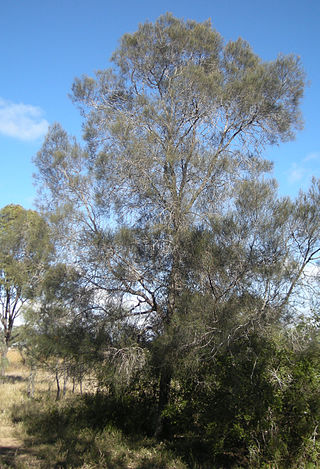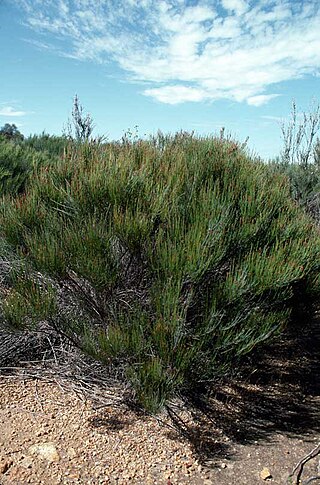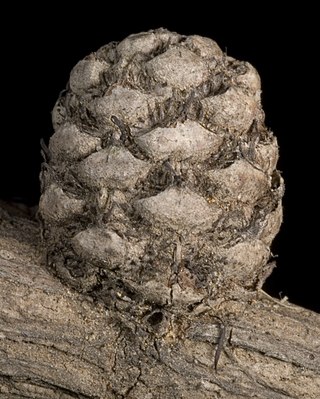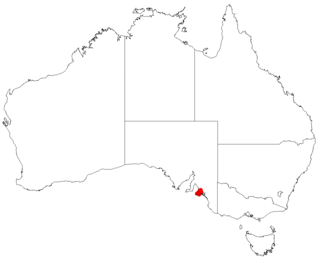
Allocasuarina lehmanniana, commonly known as dune sheoak, is a species of flowering plant in the family Casuarinaceae and is endemic to near-coastal areas of the south-west of Western Australia. It is dioecious or less commonly a monoecious shrub that has its leaves reduced to scales in whorls of six to eight, the mature fruiting cones 12–35 mm (0.47–1.38 in) long containing winged seeds (samaras) 4.0–5.5 mm (0.16–0.22 in) long.

Allocasuarina luehmannii, commonly known as bull-oak or buloke or bull-oak, is a species of flowering plant in the family Casuarinaceae and is endemic to south-eastern continental Australia. It is a dioecious tree, that has its leaves reduced to scales in whorls of ten to fourteen, and the mature fruiting cones are 5–12 mm (0.20–0.47 in) long containing winged seeds (samaras) 4–5 mm (0.16–0.20 in) long.

Allocasuarina littoralis, commonly known as black she-oak, is a species of flowering plant in the family Casuarinaceae and is endemic to eastern Australia. It is dioecious, or less commonly a monoecious tree or shrub, that has its leaves reduced to scales, usually in whorls of six to eight, the mature fruiting cones 10–30 mm (0.39–1.18 in) long containing winged seeds (samaras) 4.0–10 mm (0.16–0.39 in) long.

Allocasuarina campestris is a species of flowering plant in the family Casuarinaceae and is endemic to the south-west of Western Australia. It is a dense, monoecious or dioecious shrub that has more or less erect branchlets, the leaves reduced to scales in whorls of seven to nine, the mature fruiting cones 19–42 mm (0.75–1.65 in) long containing winged seeds (samaras) 4.7–10 mm (0.19–0.39 in) long.

Allocasuarina paludosa, commonly known as swamp she-oak or scrub sheoak, is a species of flowering plant in the family Casuarinaceae and is endemic to south-eastern continental Australia. It is a monoecious or dioecious shrub that has branchlets up to 200 mm (7.9 in) long, the leaves reduced to scales in whorls of six to eight, the fruiting cones 10–18 mm (0.39–0.71 in) long containing winged seeds 3.5–5.0 mm (0.14–0.20 in) long.

Allocasuarina paradoxa is a species of flowering plant in the family Casuarinaceae and is endemic to Victoria. It is a dioecious or monoecious shrub that has branchlets up to 150 mm (5.9 in) long, the leaves reduced to scales in whorls of seven to eleven, the fruiting cones 13–25 mm (0.51–0.98 in) long containing winged seeds 4–8 mm (0.16–0.31 in) long.

Allocasuarina acutivalvis is a species of flowering plant in the family Casuarinaceae and is endemic to the southwest of Western Australia. It is a dioecious shrub to small tree that has erect branchlets, the leaves reduced to scales in whorls of 10 to 14, the fruiting cones 15–35 mm (0.59–1.38 in) long containing winged seeds (samaras) 6–12 mm (0.24–0.47 in) long.

Allocasuarina dielsiana, commonly known as northern sheoak, is a species of flowering plant in the family Casuarinaceae and is endemic to the south-west of Western Australia. It is a dioecious tree that has more or less erect branchlets, the leaves reduced to scales in whorls of six to eight, and the mature fruiting cones 14–30 mm (0.55–1.18 in) long containing winged seeds (samaras) 8–10 mm (0.31–0.39 in) long.

Allocasuarina drummondiana is a species of flowering plant in the family Casuarinaceae and is endemic to the south-west of Western Australia. It is an intricately branched, dioecious shrub that has its leaves reduced to scales in whorls of six or seven, the mature fruiting cones 8–15 mm (0.31–0.59 in) long containing winged seeds (samaras) 3–4 mm (0.12–0.16 in) long.

Allocasuarina eriochlamys is a species of flowering plant in the family Casuarinaceae and is endemic to inland areas of Western Australia. It is a dense, erect, monoecious or dioecious shrub that has more or less erect branchlets, its leaves reduced to scales in whorls of eight to ten, the mature fruiting cones 20–45 mm (0.79–1.77 in) long containing winged seeds (samaras) 5.0–10.5 mm (0.20–0.41 in) long.

Allocasuarina fibrosa, commonly known as woolly sheoak, is a species of flowering plant in the family Casuarinaceae and is endemic to the south-west of Western Australia. It is a dioecious shrub that has branchlets 20–50 mm (0.79–1.97 in) long, the leaves reduced to scales in whorls of four, and the mature fruiting cones 11–25 mm (0.43–0.98 in) long containing winged seeds (samaras) 6–7 mm (0.24–0.28 in) long.

Allocasuarina grevilleoides is a species of flowering plant in the family Casuarinaceae and is endemic to the south-west of Western Australia. It is a small, spreading, dioecious shrub that forms a lignotuber, and has more or less erect, sharply-pointed branchlets, the leaves reduced to scales in whorls of four, the mature fruiting cones 9–14 mm (0.35–0.55 in) long containing winged seeds (samaras) 5.5–7.0 mm (0.22–0.28 in) long.

Allocasuarina ramosissima is a species of flowering plant in the family Casuarinaceae and is endemic to the south-west of Western Australia. It is a dioecious shrub with its leaves reduced to overlapping scales in whorls of five, the mature fruiting cones sessile and 9–13 mm (0.35–0.51 in) long, containing winged seeds 4.5–5.0 mm (0.18–0.20 in) long.

Allocasuarina scleroclada is a species of flowering plant in the family Casuarinaceae and is endemic to areas along the south coast of Western Australia. It is a straggly, dioecious shrub that has branchlets up to 230 mm (9.1 in) long, the leaves reduced to scales in whorls of ten or eleven, the mature fruiting cones 18–25 mm (0.71–0.98 in) long containing winged seeds 5–8 mm (0.20–0.31 in) long.

Allocasuarina spinosissima is a species of flowering plant in the family Casuarinaceae and is endemic to Western Australia. It is a monoecious shrub with its leaves reduced to overlapping scales in whorls of nine to eleven, the mature fruiting cones 10–23 mm (0.39–0.91 in) long, containing winged seeds 5.5–7.0 mm (0.22–0.28 in) long.
Allocasuarina tessellata is a species of flowering plant in the family Casuarinaceae and is endemic to the south-west of Western Australia. It is a dioecious shrub or tree that has more or less erect branchlets, the leaves reduced to scales in whorls of eight or nine, the mature fruiting cones 26–55 mm (1.0–2.2 in) long containing winged seeds 5.0–7.5 mm (0.20–0.30 in) long.

Allocasuarina thuyoides, commonly known as horned sheoak, is a species of flowering plant in the family Casuarinaceae and is endemic to the south-west of Western Australia. It is monoecious or dioecious shrub that has its leaves reduced to scales in whorls of five or six, the mature fruiting cones 8–20 mm (0.31–0.79 in) long containing winged seeds usually 5.0–6.0 mm (0.20–0.24 in) long.

Allocasuarina muelleriana, commonly known as slaty sheoak, is a species of flowering plant in the family Casuarinaceae and is endemic to southern continental Australia. It is a dioecious, rarely a monoecious shrub that has branchlets up to 120 mm (4.7 in) long, the leaves reduced to scales in whorls of five to eight, the fruiting cones 14–30 mm (0.55–1.18 in) long containing winged seeds 6–9 mm (0.24–0.35 in) long.

Allocasuarina pusilla, commonly known as heath oak-bush or dwarf sheoak, is a species of flowering plant in the family Casuarinaceae and is endemic to south-eastern continental Australia. It is a spreading, dioecious shrub with branchlets up to 120 mm (4.7 in) long, the leaves reduced to scales in whorls of five to seven, the fruiting cones 10–15 mm (0.39–0.59 in) long containing winged seeds about 5 mm (0.20 in) long.

Allocasuarina robusta, commonly known as Mount Compass oak-bush, is a species of flowering plant in the family Casuarinaceae and is endemic to a restricted area of South Australia. It is a monoecious, rarely a dioecious shrub with erect branchlets up to 200 mm (7.9 in) long, the leaves reduced to scales in whorls of five to seven, the fruiting cones 12–20 mm (0.47–0.79 in) long containing winged seeds about 5.5–6.0 mm (0.22–0.24 in) long.





















